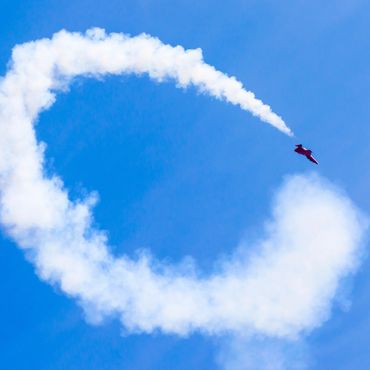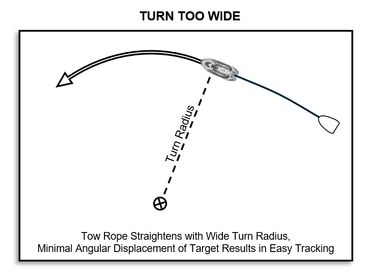COMBAT AQUATICS: THE FIGHTER PILOT EXPERIENCE
WHY DRIVING A JET SKI FEELS LIKE FLYING A FIGHTER JET
Combat Aquatics isn't just another water activity. It's a meticulously designed experience that replicates the feeling, precision, and tactics of flying a fighter jet — all while skimming across the water on our specialized HydroFighters™.
While the actual physics is different — the feeling is the same.
Fluid Dynamics — Moving Through Air and Water
At their core, both fighter jets and HydroFighters™ operate on the same fundamental principle: Newton's Third Law of Motion. They move forward by pushing a fluid backward.
The Power of Thrust:
- Aircraft engines accelerate air, pushing it out the back to propel the aircraft forward
- HydroFighters™ do exactly the same thing with water — the jet pump draws water in, accelerates it, and expels it out the back
- Both create thrust through this equal and opposite reaction with their surrounding fluid
Turning Through Fluid Manipulation: Both aircraft and watercraft turn by creating counterpressure against the fluid they travel through:
- Aircraft: Use control surfaces like ailerons, rudders, and flaps to deflect air, creating pressure differentials that cause the aircraft to bank and turn.
- HydroFighters™: Combine thrust vectoring (directing the jet nozzle) with sponsons (the wing-like structures on the sides of the hull) that act like hydrofoils, creating stability and leverage points for turns.
This shared relationship with fluid dynamics is why piloting a HydroFighter™ feels so similar to flying a jet. Both require you to think in terms of thrust management and fluid resistance, creating that authentic aviation experience on the water.
Linear Acceleration — Pure, Instant Power
In your car, acceleration isn't simple. Fuel is injected into the engine, which transfers power to the axle, which is then filtered through gears and a transmission, creating that familiar pattern of acceleration - shifting - hesitation - acceleration.
Fighter jets and our HydroFighters™ are different:
- More throttle = More speed
- Less throttle = Less speed
- No gears. No transmission. No delay.
Just like a fighter pilot slamming the throttles to MAX, a HydroFighter™ responds instantly to your input. The power is linear, immediate, and completely in your control.
Rolling Into Turns — Just Like a Jet
Ever notice how fighter jets bank when they turn? They don't stay flat like a car. This isn't just for show — it's physics.
Fighter Aircraft: Aircraft generate lift through their wings, perpendicular to the wing surface. To turn, pilots use ailerons to roll the aircraft, redirecting the lifting force, or “lift vector” inward to create the centripetal force needed to turn.
HydroFighters™: Our watercraft use thrust vectoring — pivoting the nozzle beneath the craft. Since the nozzle sits below the center of gravity, this creates a natural rolling motion into the turn.
Different mechanisms, but the same result: both machines roll into the direction of turn, creating that distinctive fighter pilot feeling.
The Pointy Nose — Form Follows Function
The sharp, pointed nose isn’t just about looks — it signals power and aerodynamic performance. When pilots transition from propeller aircraft to jets, the pointed nose is one of the first things they notice. The HydroFighter™ carries that same aggressive profile — a visual reminder that this machine is built to perform.
MASTERING ENERGY MANEUVERABILITY
It's Not Just About Speed — It's About Control
Fighter pilots don't just fly fast — they master the delicate balance of speed and turn.
In aviation, it's called Energy Maneuverability (EM) — the art of managing:
- Speed (too much limits turning ability; too little makes you vulnerable)
- G-forces (harder banks increase turn rate, but cost more energy)
- Thrust (your power reserve)
"The goal isn't just to go faster — it's to go around the circle faster"
Think of it like a game of Duck Duck Goose — success isn't about who can run the fastest in a straight line. It's about who can get back to the starting point or tag the other player first.
On our HydroFighters™, coupled with our tethered target model, you'll face the same challenge: balancing speed with turn rate to maximize your angular velocity, or "turn rate — how quickly you can maneuver around your opponent.



PURSUIT CURVES: AVIATION TACTICS ON WATER
From World War II to the Water
The principles of aerial pursuit were forged in the intense dogfights of World War II, where pilots had to calculate intercepts mentally while managing their aircraft under extreme g-forces. Without computer assistance, these aviators relied on instinct, training, and a deep understanding of pursuit geometry.
In his groundbreaking Aerial Attack Study, legendary fighter pilot John Boyd determined that pursuit success depends on three key factors: your speed, your opponent's speed, and the angle between you. As range decreases, the required turn rate increases - a principle that applies whether you're flying at 20,000 feet or skimming across the water.
Understanding the Angles
Before mastering pursuit curves, you need to understand two key concepts:
Angle-Off-Tail: The angle between your opponent's tail and your position. A small angle means you're directly behind them.
Angle-Off-Nose: The angle between your nose and your opponent's location. A small angle means you are pointed at your opponent.

The Three Pursuit Options
On your HydroFighter™, you'll learn and apply the same three pursuit curves that fighter pilots use:
Pure Pursuit: Aiming directly at the target.
- You're pointing straight at your opponent
- Decreases range quickly
- Maintains the same angle off tail
- Best used when: You need to close distance without changing your position
Lead Pursuit: Aiming ahead of where the target is going.
- You're cutting the corner of their turn
- Decreases range
- Increases angle off tail (moves you further from being directly behind them)
- Best used when: You need to intercept quickly or are in a favorable position
Lag Pursuit: Aiming behind the target's flight path.
- You're taking a wider turn than your opponent
- Increases range
- Decreases angle off tail (positions you more directly behind them)
- Best used when: You need to set up a better position for later

Applying Fighter Pilot Tactics
During your Combat Aquatics session, you'll apply these same tactical decisions that fighter pilots use - choosing lead pursuit to close distance quickly, lag pursuit to set up a better position, or pure pursuit to maintain your current advantage.
Just like WWII fighter pilots, you'll learn to instinctively recognize which pursuit option gives you the best position. It's not just about speed - it's about understanding when to cut the corner, when to swing wide, and how to apply these authentic aviation principles on the water.
THE TETHERED TARGET SYSTEM
Air Combat Tactics — On Water
In aerial dogfights, fighter pilots maneuver to get behind their opponent's "vulnerability cone" — the area where an aircraft is most exposed.
We replicate this with our unique tethered target system. Each HydroFighter™ tows a floating target that represents an aircraft's vulnerable tail. Your mission: protect your target while trying to get behind your opponent's. But as in real aerial combat, turning harder doesn't always mean turning better — it's about maximizing Energy Maneuverability.
Energy Maneuverability in Action
The tethered target transforms abstract fighter pilot theory into visible, tangible results. Every decision about speed, turn rate, and energy state directly affects your target's movement:
- Turn Too Tight: If you tighten your turn too much, your target just spins in place — or worse, the rope slackens, killing movement entirely and leaving you an easy mark.
- Turn Too Wide: If you don’t turn sharply enough, your target follows a predictable, easy-to-intercept path — giving your opponent the advantage and leaving you chasing to regain control.
- Finding the Sweet Spot: The key is balancing speed and turn radius — fast enough to pull your target away, yet tight enough to maneuver effectively against your opponent. Finding that balance isn’t static — it’s a constant battle to stay one step ahead.
Just like fighter pilots use Energy Maneuverability to dominate the fight, you'll master balancing speed, turn radius, and positioning to protect your target — while hunting down your opponent's.



Mastering the System
Success requires the same skills fighter pilots develop: precision throttle control, optimal turn rates, and tactical decision-making. You'll learn to:
- Read your opponent's energy state by observing their target's movement
- Predict how changes in your speed and turn radius will affect your target's position
- Apply pursuit curves strategically to maximize your advantage
This isn't just a game of tag on water—it's a sophisticated application of the same principles that govern air combat maneuvering, made accessible and exhilarating on the water.
SIGN UP NOW!!!
Combat Aquatics is more than an adrenaline rush — it's a chance to test yourself, master a new skill set, and experience the unique mindset of fighter pilots.
When it's over, you won't just walk away with a good time.
You'll leave with a new understanding of what it means to control a high-performance machine, make split-second tactical decisions, and push your boundaries.
You'll walk away changed — sharper, stronger, and awakened to what's possible when you take control and push yourself.
That's Combat Aquatics.
Copyright © 2025 Combat Aquatics LLC - All Rights Reserved.
This website uses cookies.
We use cookies to analyze website traffic and optimize your website experience. By accepting our use of cookies, your data will be aggregated with all other user data.